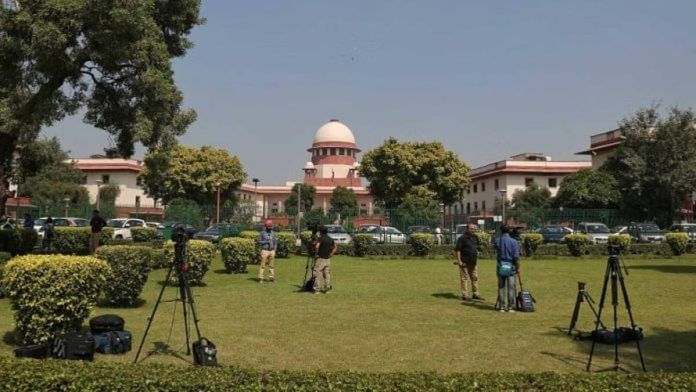New Delhi: The Centre last week asked the Supreme Court to restrict its judgment, which directed gender-neutral recruitment to the Army’s Judge Advocate General (JAG) posts, to just the Army’s JAG, not extending to other services of the Army or the Indian Air Force (IAF) and Indian Navy.
It was on 11 August that a Justice Dipankar Datta-led division bench of the Supreme Court had delivered the landmark order on applying a gender-neutral employment policy in the Army’s JAG cadre.
In an application filed before the top court, the Centre, through its Union Ministry of Defence, has now sought a clarification that the SC judgment delivered in August this year would not have any bearing on hirings to other Army branches.
The Centre’s application submitted that the SC’s 11 August judgment, rendered in a specific context for the JAG branch, was based on facts and circumstances unique to that cadre, but is being relied upon for recruitments to other branches of the Indian Armed Forces.
In its plea, the Centre cited a 25 August Delhi High Court order, which, relying upon the SC’s JAG order, directed the IAF to appoint a successful woman candidate to a flying post.
In that case, the officer approached the court when she was not hired, despite qualifying for the post with “fit to fly” certificates and 20 vacancies. The IAF’s argument in the Delhi HC—20 of those posts remained reserved for male candidates—was quashed.
“In the light of the above, it is most respectfully prayed that the said judgment is confined to recruitment in the Army’s JAG branch alone and shall not be treated as a binding precedent in relation to recruitment or service conditions in other branches of the Indian Army, Navy, or Air Force,” the Centre’s plea said.
Key points of SC’s JAG order
On 11 August, the top court opined that reserving more seats for men would violate the constitutional right to equality, since both the male and female JAG officers belonged to the same cadre with identical service conditions. Unequal allocation of vacancies excluded women officers, even as they scored higher than their male counterparts, the top court had observed in its judgment.
The SC judgment made it mandatory for the Army to select its officers for JAG based on merit, regardless of gender. The JAG branch’s primary role is to provide legal advice and services, as well as manage and conduct cases for the armed forces. Each service has its own JAG unit that handles litigation.
As part of its wide-ranging legal duties, JAG prosecutes erring officers, defends the armed forces in court-martial proceedings, and drafts legal documents for all types of litigation, from international to environmental. In view of the nature of work that the JAG does, the SC’s August verdict mandated gender-neutral recruitment to the Army’s JAG cadre.
And, to correct the past exclusion of women from the branch, Justice Datta’s bench, in its August judgment, also ordered the Army to allocate 50 percent of its vacancies to women. Simultaneously, it clarified that there could not be a cap preventing women from exceeding 50 percent if they scored higher than their male counterparts.
Moreover, the SC made it mandatory for the Army to prepare and publish a common merits list for all JAG candidates, male or female, including the marks obtained by each candidate.
Through a later order, the top court clarified that its judgment would be prospectively effective.
Centre’s arguments
Questioning the logic behind the 50 percent reservation for women, the Centre’s present application submitted that the 11 August direction of the SC was inconsistent with its mandate to implement merit-based, gender-neutral recruitment to the Army’s JAG cadre. The direction to reserve endorsed a rigid quota, based solely on gender, thereby creating an internal inconsistency, stressed the Centre in its application.
The Centre, which had strongly advocated for gendered vacancies in JAG, opposing the gender-neutral appointments, has in its present application argued against the quota for women, as well. Its contention is that the move would lead to disproportionate or excessive exclusion of male candidates, besides being at odds with the constitutional principles of affirmative action and efficiency.
“A rigid 50 percent allocation to women, regardless of performance on the merit list, risks displacing more meritorious male candidates, thereby undermining the constitutional principle of efficiency in public employment, as emphasised by this honourable court in its observations concerning the efficiency of the JAG branch,” it claimed.
It also conveyed there would be “systematic exclusion” of meritorious male candidates due to the reservation directive. It would not only impact the overall quality of intake into the JAG branch but also frustrate the objective of ensuring operational efficiency—as underscored in the HC’s 11 August judgment—the Centre maintained in its application.
According to the Centre, “the artificial reduction in the intake of male candidates is likely to distort the long-term cadre structure, with cascading implications on promotions, seniority, command assignments, and the overall organisational balance within the JAG branch.”
(Edited by Madhurita Goswami)
Also Read: Demand for green crackers picks up at market near Delhi’s Jama Masjid, but there’s no ‘variety’






